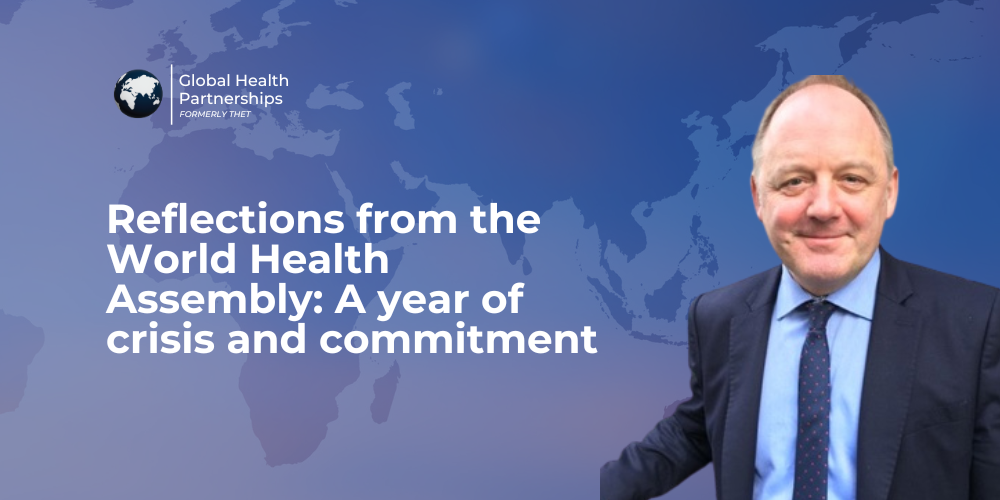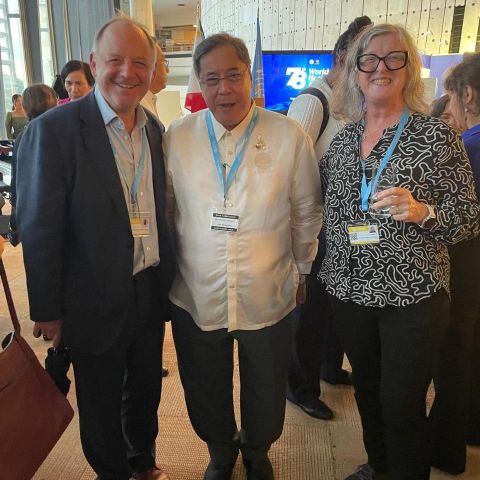Reflections from the World Health Assembly: A year of crisis and commitment
29 May 2025

This year’s World Health Assembly (WHA) was held against a backdrop of unprecedented cuts to global health funding. And yet, amidst the uncertainty, there emerged a shared sense of resolve and renewed commitment to a more resilient and equitable future for global health.
For Global Health Partnerships, it was a moment to convene, reflect, and push forward. We co-hosted two high-level side events—one with the UK Government, another with the World Health Organization (WHO)—and joined urgent conversations that laid bare the pressures on the global health system.
Aid cuts dominated the narrative
Even as delegates gathered in Geneva, WHO was issuing redundancy notices to its staff—a stark reminder of the financial crisis gripping the organisation. These cuts are part of a wider trend: an estimated 700,000 frontline health workers have lost their jobs globally due to shrinking aid budgets, along with staff in the voluntary sector, academia, and research. The human cost is incalculable.
WHO now faces the most serious budget shortfall in its nearly 80-year history. In his appeal for $2.1 billion in emergency funding, Dr Tedros painted a sobering picture: this is the equivalent of global military spending every eight hours, the price of a single stealth bomber, or just one-quarter of what the tobacco industry spends on advertising each year. “It seems somebody switched the price tags on what is truly valuable in our world,” he said.
Some continue to advocate for the restoration of aid. Dr Ashok Philip, President of the World Medical Association, argued that just as high-income countries have increased defence budgets in response to U.S. cuts, so too should they step up to fill the health funding gap.
But there is a growing sense that the global conversation has shifted. As South Africa’s Health Minister Dr Aaron Motsoaledi told delegates, “I am stunned by the USAID cuts—but in my opinion, President Trump has fast-tracked what was going to happen anyway.” The message is clear: countries must mobilise domestic resources to fund their own health systems.
Multilateralism is alive—barely
The U.S. was notably absent, while China sent its largest-ever delegation of 180 representatives.
Despite geopolitical tensions, one major achievement stood out: the adoption of the Pandemic Agreement after three years of negotiations, passed with 124 votes in favour, none opposed, and 11 abstentions.
Yet critical issues remain unresolved—notably the question of pathogen access and benefit sharing. What will countries receive in return for sharing data on emerging pathogens? That debate continues.
Health workforce and migration finally took centre stage
This year, the conversation on health workforce moved from the margins to the spotlight.
At the 37th Commonwealth Health Ministers Meeting just before WHA, ministers endorsed investment in the health and care workforce and acknowledged the serious consequences of health worker migration for Small Island Developing States (SIDS) and Low- and Middle-Income Countries (LMICs).
At the Assembly itself, Global Health Partnerships contributed to these discussions with a closed-door roundtable with ministries of health, multilateral agencies, professional associations and international networks. Our focus: strengthening bilateral agreements to ensure mutual benefit in global workforce mobility.
A high point came with the adoption of the resolution “Accelerating Action on the Global Health and Social Care Workforce” on Monday, energising efforts to build and retain a sustainable workforce.
The issue of migration was also discussed more openly than ever before. The State of the World’s Nursing Report, released in early May, revealed that one in seven nurses worldwide in 2023 was trained abroad, with ten high-income countries benefiting disproportionately.

Philippine Health Minister Ted Herbosa shared a striking statistic: his country graduates 10,000 nurses annually—yet 13,000 leave to work overseas. “It’s not sustainable,” he noted, adding that migration brings no fiscal return to the national budget. Perhaps, he suggested, it’s time to consider tariffs. One African minister compared the export of health professionals to the export of oil: the latter is taxed, the former is not.
Germany outlined its Global Skills Partnership programme, and Austria committed to awarding a fellowship to a young Filipino nurse for every nurse it recruits. The UK—despite having promising models like the Global Health Workforce Programme—was notably silent.
One new statistic began to resonate across the Assembly: by recruiting health workers internationally rather than investing in their education and training domestically, high-income countries receive an education subsidy worth $270 billion. This enormous transfer of value from low- to high-income countries calls for urgent reflection.
It has been 21 years since the WHA first adressed the issue of health workforce migration, and 15 since the Code of Practice on International Recruitment was adopted. Are we finally reaching a turning point, driven by the growing confidence of countries who are supplying most of the world’s health professionals?
Partnerships: a buzzword at risk
The term “partnerships” were a common refrain throughout the Assembly—perhaps too common.
It was the theme of our Monday night side event co-hosted with the UK Government and chaired by Professor Ged Byrne. We were honoured to welcome speakers such as the Hon. Margaret Muhanga, Uganda’s State Minister for Primary Healthcare, and Catherine Frances CB, Director General for Global and Public Health at the UK Department of Health and Social Care. The discussion focused on the UK’s engagement at the systems level, through institutional twinning and peer-to-peer learning.
I used the moment to emphasise the themes of this blog—particularly how the UK benefits from these collaborations. But outside our session, the term ‘partnership’ often felt vague, unanchored from the accountability and clarity that traditional aid once brought. Without deeper commitments, there’s a risk that the word becomes hollow.
The world keeps turning
While conversations unfolded in Geneva, health workers around the world continued to lose their jobs. People continued to lose access to health care and lives are being lost. Conflicts rage in Gaza, Myanmar, and beyond. A report released during the Assembly—Attacks on Healthcare in War Zones Reach New Levels of Horror—brought this reality into sharp focus.
Let us hope that this year’s Assembly, amidst its crises and conversations, has done something to help us meet these unprecedented challenges. At Global Health Partnerships, we are proud to be part of that journey.


2 Comments
Leave a comment
Your email address will not be published.